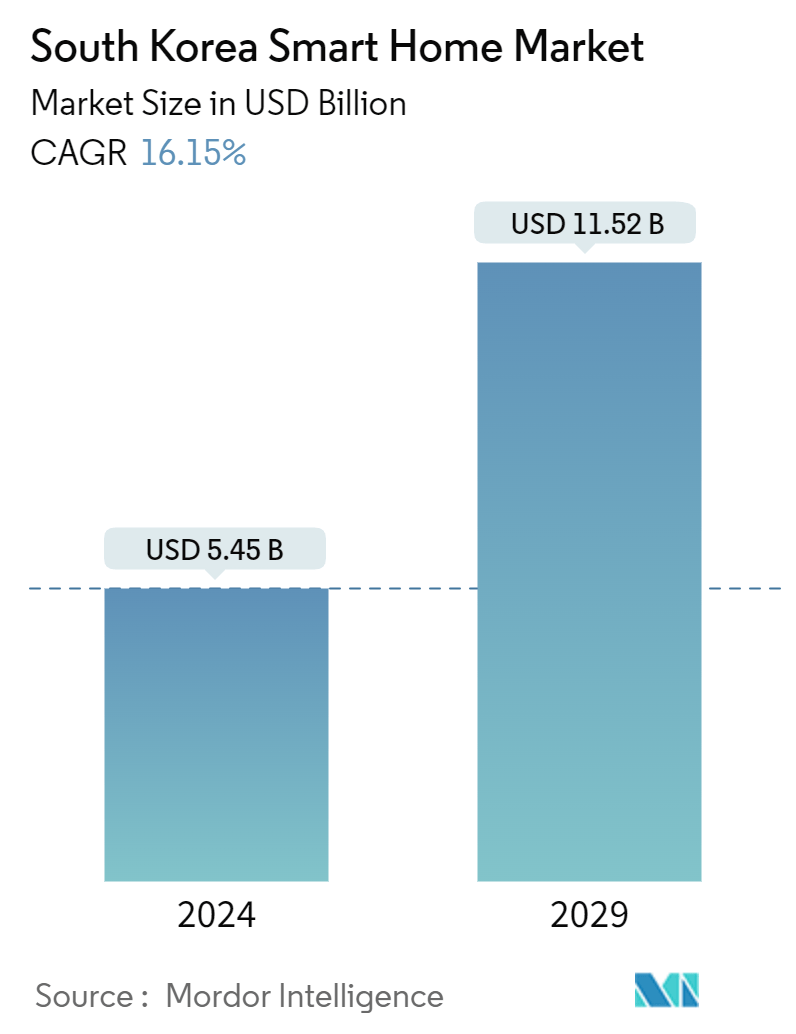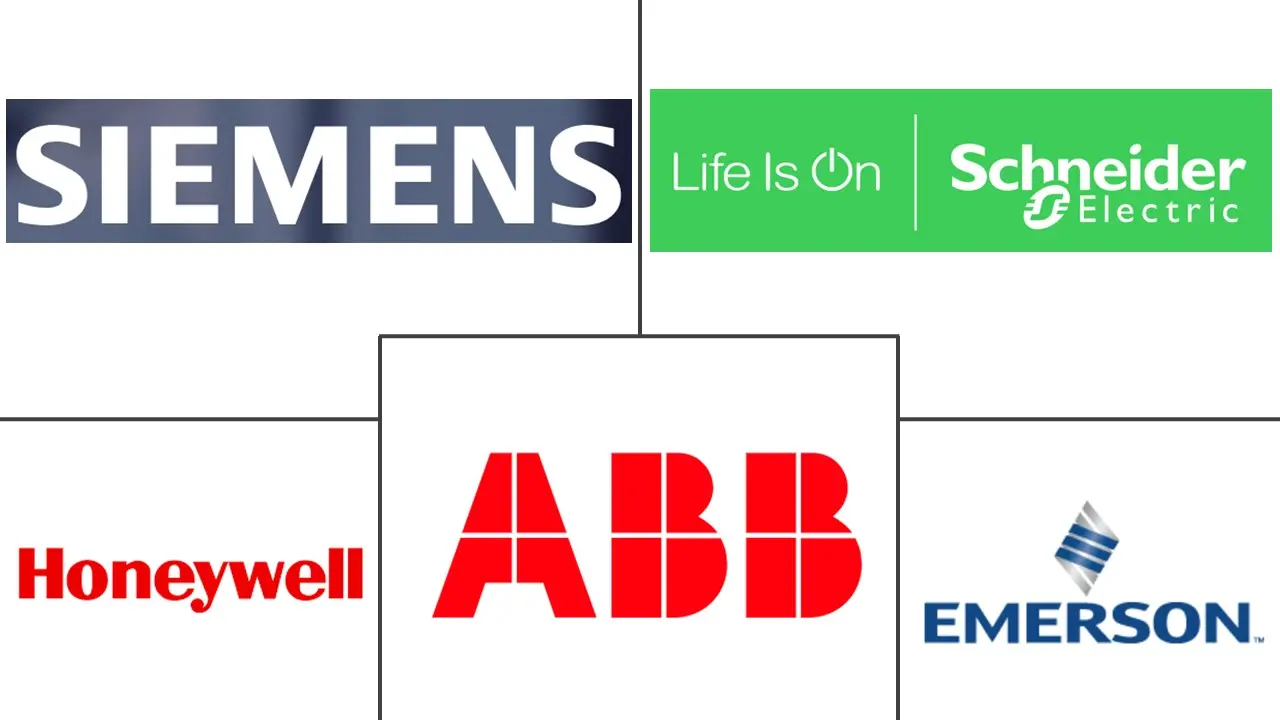Market Size of South Korea Smart Home Industry

| Study Period | 2019 - 2029 |
| Base Year For Estimation | 2023 |
| Market Size (2024) | USD 5.45 Billion |
| Market Size (2029) | USD 11.52 Billion |
| CAGR (2024 - 2029) | 16.15 % |
| Market Concentration | Low |
Major Players
*Disclaimer: Major Players sorted in no particular order |
South Korea Smart Home Market Analysis
The South Korea Smart Home Market size is estimated at USD 5.45 billion in 2024, and is expected to reach USD 11.52 billion by 2029, at a CAGR of 16.15% during the forecast period (2024-2029).
- Concerns about home security and safety are driving the expansion of South Korea's smart home market. With urbanization on the rise and more households having dual incomes, there's a growing demand for technologies that protect homes and their inhabitants. Features like remote monitoring, enhanced surveillance, and access control are pivotal in encouraging the shift toward smart security solutions.
- Heightened awareness of both physical and digital vulnerabilities has led to a surge in the adoption of smart security systems. These encompass smart locks, surveillance cameras, motion sensors, and AI-driven monitoring tools, all of which empower homeowners with real-time remote oversight, bolstering their security.
- The integration of security features into homes is becoming seamless, thanks to the widespread adoption of IoT-enabled devices. In response to this growing demand, companies are rolling out advanced, user-centric smart home solutions. These offerings frequently include added automation capabilities, such as energy management and appliance control, broadening their appeal.
- However, the smart home market grapples with challenges, notably the intricate nature of installing and integrating multiple devices. Many systems require extensive wiring, specific network configurations, and the smooth coordination of various appliances and sensors. Given that urban areas, particularly apartments, dominate South Korea's housing scene, retrofitting these spaces with cutting-edge smart technologies proves daunting. This is especially true for older apartment complexes in cities like Seoul and Busan, which often lack modern infrastructure. As a result, homeowners and tenants struggle with system setups, especially when aiming for seamless integration on a unified network.
- The COVID-19 pandemic has heightened the demand for smart home devices, leading consumers in the country to favor smart appliances over traditional electronics. Luxury residential real estate firms are now incorporating voice and motion sensor controls into their projects. In a post-pandemic world, these features are becoming essential in modern properties. With mobile phone integration, these properties might soon offer remote switching from any location. While luxury smart homes previously allowed users to activate the bedroom air conditioner from a distance, the next evolution will see nearly all major appliances under remote control.
South Korea Smart Home Industry Segmentation
A smart home refers to a set of integrated and networked devices that automate different functions within a home and can communicate with each other and with a centralized control interface. The prominent purpose of this type of system is to enhance comfort, safety, energy efficiency, and management of household resources.
The South Korean smart home market is segmented by product type (comfort and lighting, control and connectivity, energy management, home entertainment, security, smart appliances, and HVAC control) and technology (Wi-Fi, Bluetooth, and other technologies). The market sizes and forecasts are provided in terms of value (USD) for all the above segments.
| By Product Type | |
| Comfort and Lighting | |
| Control and Connectivity | |
| Energy Management | |
| Home Entertainment | |
| Security | |
| Smart Appliances | |
| HVAC Control |
| By Technology (Qualitative Analysis) | |
| Wi-Fi | |
| BlueTooth | |
| Other Technologies |
South Korea Smart Home Market Size Summary
The South Korean smart home market is poised for significant expansion, driven by the country's robust digitalization strategy and commitment to advanced technologies like IoT and 5G. The government's "infrastructure-first" approach to digital transformation has been instrumental in fostering an inclusive environment for innovation, making smart home automation a natural progression. South Korea's exceptional connectivity, with universal household internet access, supports the seamless integration of smart technologies into daily life. The nation's focus on smart city initiatives further amplifies the adoption of smart home solutions, as urban areas evolve into more sustainable and efficient entities. Despite challenges such as cybersecurity threats, South Korea's advanced ICT infrastructure and strategic geopolitical position make it an attractive market for smart home development.
The market landscape is characterized by a mix of small and large players, with major companies like Schneider Electric, Emerson Electric, ABB, Honeywell, and Siemens holding significant shares. These companies are actively expanding their global presence through collaborations, partnerships, and product innovations. The South Korean government's initiatives, such as the "Intelligent Home" project, highlight the country's commitment to enhancing residential living through smart technologies. Additionally, the focus on energy efficiency and sustainability is driving the adoption of smart home solutions, such as advanced HVAC systems and smart LED lighting, which contribute to reducing energy consumption. As the market continues to evolve, the integration of AI and IoT technologies is expected to play a crucial role in shaping the future of smart homes in South Korea.
South Korea Smart Home Market Size - Table of Contents
-
1. MARKET INSIGHTS
-
1.1 Market Overview
-
1.2 Industry Value Chain Analysis
-
1.3 Industry Attractiveness - Porter's Five Forces Analysis
-
1.3.1 Bargaining Power of Suppliers
-
1.3.2 Bargaining Power of Consumers
-
1.3.3 Threat of New Entrants
-
1.3.4 Threat of Substitute Products
-
1.3.5 Intensity of Competitive Rivalry
-
-
1.4 Impact of COVID-19 Aftereffects and Other Macroeconomic Factors on the Market
-
-
2. MARKET SEGMENTATION
-
2.1 By Product Type
-
2.1.1 Comfort and Lighting
-
2.1.2 Control and Connectivity
-
2.1.3 Energy Management
-
2.1.4 Home Entertainment
-
2.1.5 Security
-
2.1.6 Smart Appliances
-
2.1.7 HVAC Control
-
-
2.2 By Technology (Qualitative Analysis)
-
2.2.1 Wi-Fi
-
2.2.2 BlueTooth
-
2.2.3 Other Technologies
-
-
South Korea Smart Home Market Size FAQs
How big is the South Korea Smart Home Market?
The South Korea Smart Home Market size is expected to reach USD 5.45 billion in 2024 and grow at a CAGR of 16.15% to reach USD 11.52 billion by 2029.
What is the current South Korea Smart Home Market size?
In 2024, the South Korea Smart Home Market size is expected to reach USD 5.45 billion.

